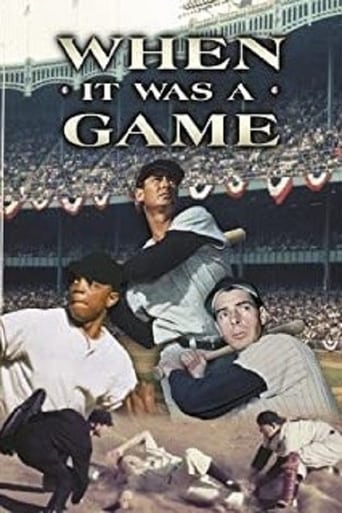

So far, HBO has made three installments of "When It Was a Game" and I've seen all of them. The second one seems to have a lot more in common with the first than the third. This is because the third only focuses on the 1960s, whereas the other two cover the 1920 to the very early 60s. Plus, like the first, "When It Was a Game 2" has many different topics and not as plot-driven as the third. None of this is meant as criticism--just a description.As I mentioned above, there are lots of different topics in this installment. They are accompanied by lots of home movies of ballplayers and ballgames (mostly in color but a few in black & white--the only ones in the series) and you never see any of the many narrators. Among the topics included the Pacific Coast League, Moe Berg and his spy duties for the US government during his trips to pre-war Japan, the so-called 'second division' teams, the Brooklyn Dodgers and their leaving Brooklyn (oddly, the Giants leaving New York was not mentioned!) and the Yankees.As with all of the films, there is an epic and almost reverential quality about the documentary as folks wax VERY lyrical and philosophical about the game. I enjoyed most of it but a few odd things I noticed were that the ball players were only occasionally identified, too many shots of the actor/ball player Chuck Connors (he only (he only played 67 major league games!) and Elston Howard as well as the strange comment by Billy Crystal. Still, well worth seeing if you are a baseball freak or casual fan.
... View MoreWhen It Was a Game 2 (1992) *** 1/2 (out of 4) Sequel to the 1991 HBO hit once again takes 8 and 16mm footage shot by MLB players and fans and present them for the first time. As with the first film, the footage here is certainly beautiful to look out and there's no question that we're lucky that the majority of this event exists for future generations to enjoy. I think the most interesting thing is just being able to see the uniforms, gloves, stadiums and of course the people who went to ballgames back in the day. Another major plus is that we get to see some famous faces including one bit where we see Tommy Lasorda when he was playing in the Minor Leagues. Some of the funniest footage comes when they talk about the cameras used at the time and how photographers for newspapers had to actually stand on the field while the game was going on to get the shots they wanted. There's a great clip of a batter swinging and behind him and on the side are four or five cameramen. Of course, the documentary also succeeds at just showing how different the game was back then in terms of how it was played but it also shows how they faced the same problems as teams today. There's a great bit about teams like the St. Louis Browns not having enough money to pay their bills so they'd have to sell players to the Yankees. We even get some nice stories and footage from the Pacific Coastal League. All of the footage is in color with the exception of about four minutes and this here is perhaps the most priceless footage because it shows Babe Ruth and Lou Gehrig in their Barnstorming days. There's also a lot of talk about the low wages paid back in the day (sometimes $850 a month) and how players really were connected to fans because a lot of times they were making the same amount of money. We even get a priceless shot of a retirement party where the player got a shotgun and two hunting dogs. The film closes with some great footage of Babe Ruth and we get a fitting tribute to the legend.
... View More